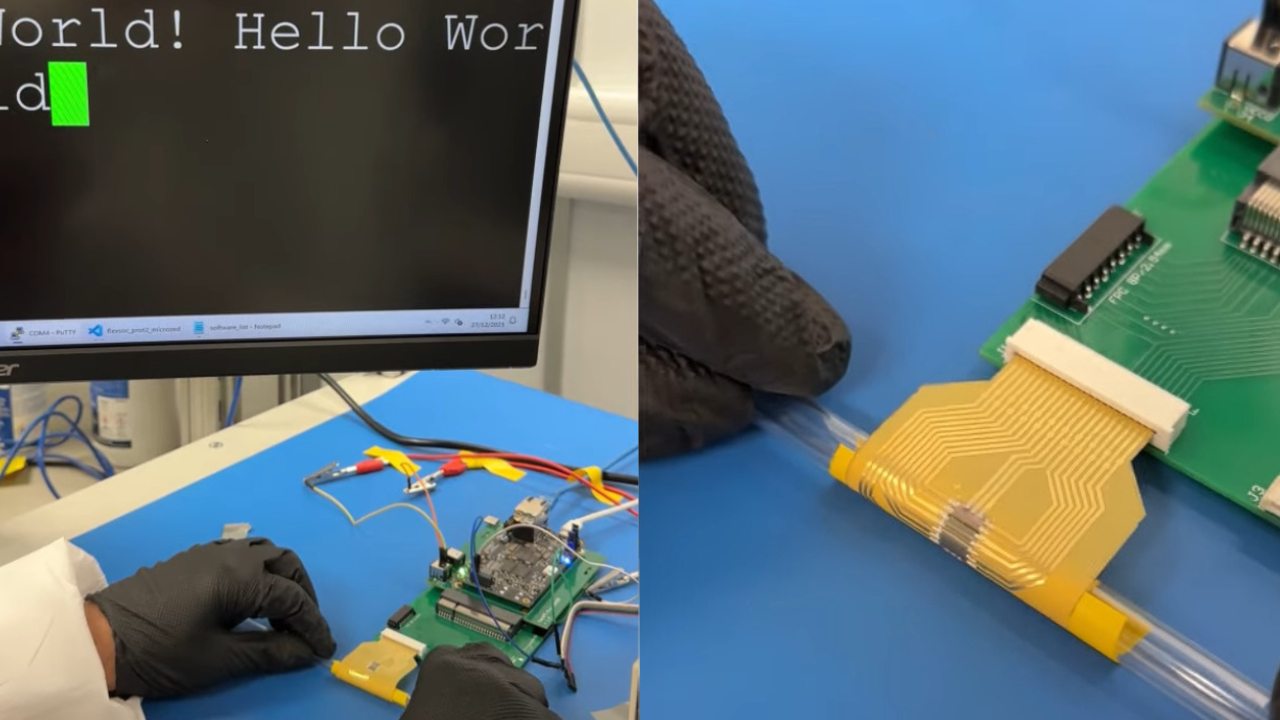The world's first fully functional 32-bit bendy CPU can run while wrapped around a straw, but boy is it slow
Intentionally bendy, anyway. I'm sure you could bend most of them a bit if you really, really tried.

While bendy, flexible screens have been demonstrated for a while now (with a fair few drawbacks, I might add), most of the components inside our devices have so far remained stiff as a board. This RISC-V processor, however, bucks that trend by being as bendy as a professional gymnast at a yoga class, even while it's running.
Pragmatic Semiconductor has published a blog announcing the hyper-flexible chip, which it says is the "world's first 32-bit microprocessor in a flexible technology that is fully functional while flexed" (via Tom's Hardware). A bit of a mouthful that—may I suggest something more catchy, like "The world's first 32-bit bendy boi"? Anyways, moving on.
The Flex-RV isn't your traditional silicon-based chip. According to the accompanying paper, it's been fabricated with indium gallium zinc oxide thin-film transistors on a flexible polyimide substrate in order to make such a flexible computational device, and I wouldn't blame you if your eyes crossed while reading that sentence. Luckily, however, Pragmatic Semiconductor has provided a demonstration video that makes the benefits of this tech abundantly clear.
The chip is shown being rolled up and then unfurled on what looks like a clear plastic straw, while running without issue. It's a bit like watching a CPU on a medieval rack, and while the flexibility is obviously impressive, our demonstrator does seem to be treating it with an overabundance of care for the most part. I'm willing to bet the prototype is still very delicate, but it's an impressive result nonetheless.
This is a RISC-V processor, which means it's based on an open standard instruction set architecture—and if you're expecting great performance, you're about to be disappointed. The test sample has 12,600 logic gates and a maximum clock speed of a stonking, err, 60 kHz.
For reference, that's 0.06 MHz, or 0.0006 GHz, although it does have an onboard ML accelerator—meaning that it's technically machine-learning capable. It's not going to be setting any performance records though, although that's hardly the purpose here.
Cost is the primary factor at play, with the aim to create a sub-dollar chip that'd be perfect for wearables or single-use healthcare equipment with minimal computational requirements. Not only that, but it sips less than 6 mW of juice, making it suitable for a variety of ultra-low power applications. Emre Ozer, Pragmatic's Senior Director of Processor Development and lead researcher, had this to say:
The biggest gaming news, reviews and hardware deals
Keep up to date with the most important stories and the best deals, as picked by the PC Gamer team.
“This is an exciting step forward in flexible semiconductor technology. Enabling an open-standard, non-silicon 32-bit microprocessor will democratise access to computing, unlocking emerging applications while opening the door to sub-dollar compute.
“By enabling scalable, low-cost compute in a flexible form factor—in combination with the rapid turnaround and low non-recurring engineering costs associated with our FlexIC Foundry, we really are ushering in a step-change in the art of the possible for flexible electronic systems.”
Looks like a properly powerful bendy chip might be some way off then, so you can put all your dreams of a gaming laptop that rolls up like a newspaper on hold for now. Still, it's quite the party trick, and potentially the first steps towards more flexible electronic devices to come.
Best CPU for gaming: Top chips from Intel and AMD.
Best gaming motherboard: The right boards.
Best graphics card: Your perfect pixel-pusher awaits.
Best SSD for gaming: Get into the game first.

Andy built his first gaming PC at the tender age of 12, when IDE cables were a thing and high resolution wasn't—and he hasn't stopped since. Now working as a hardware writer for PC Gamer, Andy's been jumping around the world attending product launches and trade shows, all the while reviewing every bit of PC hardware he can get his hands on. You name it, if it's interesting hardware he'll write words about it, with opinions and everything.



